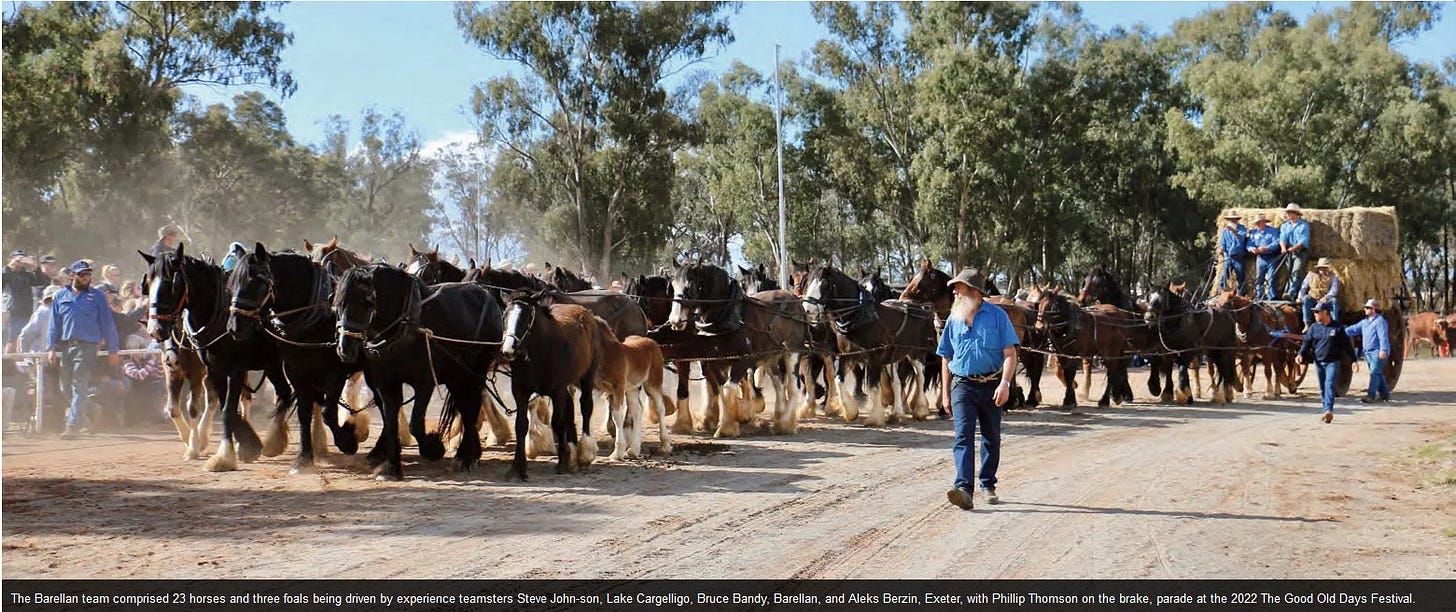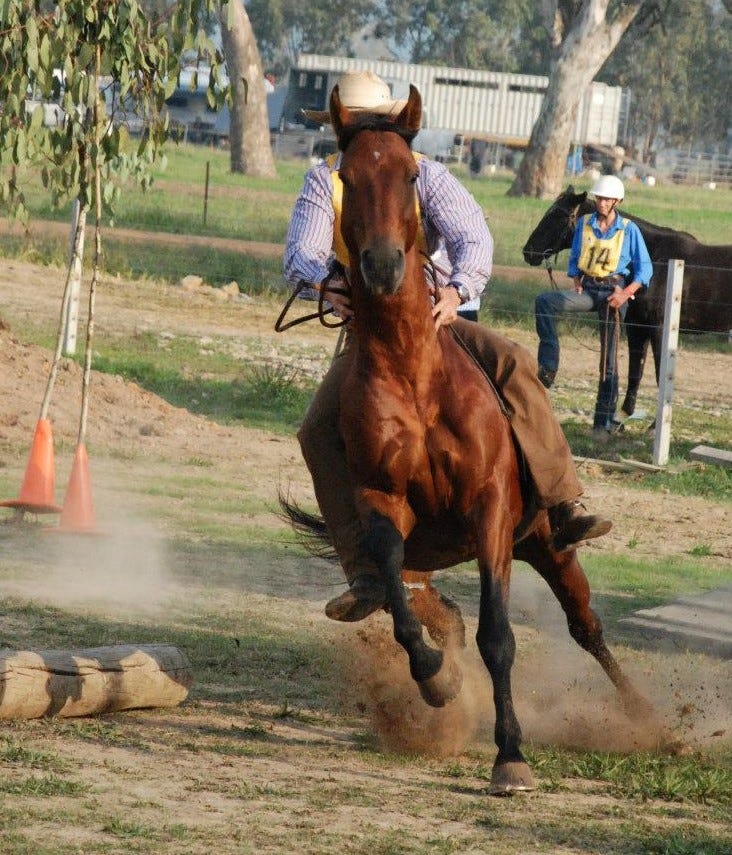Back to basics - Preserving the Legacy of the Working Horse
Are we losing the benefits of hundreds of years of selection?
From a reader
My concern goes to breeding itself i.e. Selecting the right mating for my mares with the goal of a tough 'using horse' as the result.
Fewer and fewer people are out there using horses for hours in a day, under working conditions as in ranching.
So how do we translate the show success to endurance, durability, intelligence, and disposition?
For example, the first importations of American Quarter Horses to Australia were from the King Ranch and were the result of a long time breeding program that produced horses of this type. There were very fixed breeding criteria. One example was not having broodmares with white feet to ensure a bloodline with hard durable hooves.
There were four foundational import sires of this breed to Australia. Most working Quarter Horses in Australia will have these in their background. Subsequent breeding used imported semen and also bred with Australia mares, which introduced different genetics and even colour patterns.
Are there breeders out there that are breeding in larger numbers, foal crops of say 30 a year, with full day's use in mind?
And how to find them and their stallions?
The deep dive
What a thoughtful and insightful question! Let’s unpack this together because there’s a lot to consider in terms of breeding goals, the evolution of Quarter Horse breeding in Australia, and the practicalities of finding breeders aligned with your vision.
Breeding for a tough, using horse
You’re right to prioritize durability, intelligence, and disposition over the flashiness often rewarded in the show ring. A horse that thrives under genuine working conditions needs these qualities baked into its DNA.
Historically, breeders like those at King Ranch focused on utility first—selecting for traits like strong, hard hooves (hence the avoidance of white feet), robust musculoskeletal systems, and temperaments conducive to long, taxing days in the field.
Translating this mindset to modern breeding means focusing on these same qualities:
Durability and Soundness: Seek lines known for producing horses with strong conformation, dense bone, and excellent hoof quality. Genetics still matter here, so reviewing a stallion or mare’s progeny performance under working conditions (not just arena success) is key.
Intelligence and Disposition: Look for horses from programs emphasizing trainability. The best ranch horses are sharp thinkers, quick learners, and level-headed—a trait that can often be traced back to certain bloodlines or even the ranch environments where they were raised.
Endurance: This involves careful selection for aerobic capacity, movement efficiency, and mental resilience. Horses used for campdrafting, reining, or working ranch classes often display these traits. Don’t discount racing blood either, because stamina, hardiness and economical movement is bred into the right ones.
The challenge: smaller market for working horses
You’ve nailed a key point: the dwindling number of people putting horses to work for hours on end. Most breeding programs today cater to show disciplines, which emphasize visual appeal or specialized performance over general utility.
However, pockets of breeders still prioritize functionality. You can find them on the polo / polocrosse field, at feedlots, campdrafting and on certain cattle stations in the outback. Usage requires people with the old-time skills for this work, and that too is becoming harder to find.
Even harder to find, is the genuine draft horse, the old breeds now increasingly becoming rare, because they are no longer used for agricultural and dray work. Breeders of these horses find it increasingly harder to find buyers who have a use for them, so the down side continues, to the point where is difficult to keep population numbers up to a sustainable level.
Where to find these breeders and stallions
Heritage Breeders:
Some breeders are committed to preserving the working qualities of foundational lines. In Australia, a few programs still align with these values, focusing on horses with old King Ranch or similarly established bloodlines.
In particular, there are many old racing lines which are proven tough work horses, such as that of Jet Master and Go Far Bar Bob. And the exploits of horses from breeders like Berragoon and the Haydons are well known.
Larger Breeders with working horse focus:
Breeders with larger operations (foal crops of 30+ a year) often breed for consistency and utility.
Most would be used directly on working cattle operations. There are very few of these in Australia.More and more, they are no longer using horses for work, or they are buying what they need out of the Dalby sales.
Look for breeders participating in events like stockman challenges, ranch versatility shows or even endurance events, as these highlight working horse lines.
Imported Stallions and Semen:
Many Australian breeders incorporate U.S. genetics to bring in new blood while maintaining durability and trainability.
Stallions used in ranch horse classes, versatility ranch horse competitions, working cow horse, or from operations like the Four Sixes Ranch and King Ranch in the U.S., could offer the traits you’re seeking. If you think outside the square, you might consider Argentinian horses too.
How to find them
Breed Associations Advertising and Directories: AQHA or regional Stock Horse associations can provide breeder directories. Focus on programs breeding for endurance, campdrafting or stock work.
Networking through breed associations like the Australian Quarter Horse Association (AQHA) or Australian Stock Horse Society (ASHS), might yield leads.
Events and Competitions: Attend campdrafting events or stockman challenges. Breeders showcasing their stock there often have the "using horse" qualities in mind.
Word of Mouth: Reach out to other working horse owners and breeders. Recommendations often lead to breeders flying under the radar who focus on producing tough, practical horses.
As many of these horses are crossbreds or unregistered, so you might need to search through other forums.
Social Media and Forums: Breeders today often share details of their programs online. Facebook groups or forums for working Quarter Horses can be a goldmine.
Practical questions to ask breeders
When you find a programme of interest, ask:
What are the traits they select for in their breeding stock?
Are their stallions or mares actively used in working environments?
Can they provide references or examples of progeny in long-day, working conditions?
A final thought
Breeding for a "using horse" isn’t just about selecting the right stallions or mares—it’s about embracing the values that guided programs like the King Ranch. There has been a lot written about the King Ranch so it is not hard to research the philosophies of their breeding programme.
By being intentional and seeking out breeders who share your goals, you’re helping to preserve the legacy of horses that aren’t just built for beauty but for a solid purpose. A great goal indeed.







